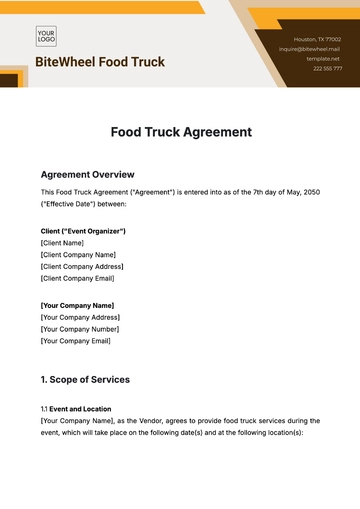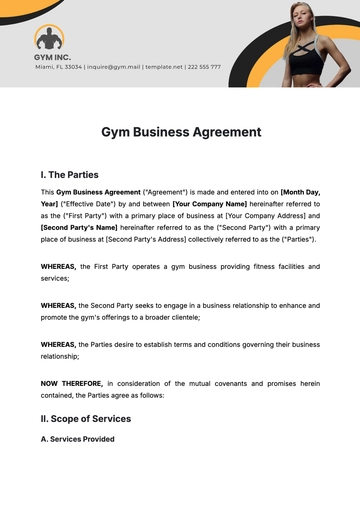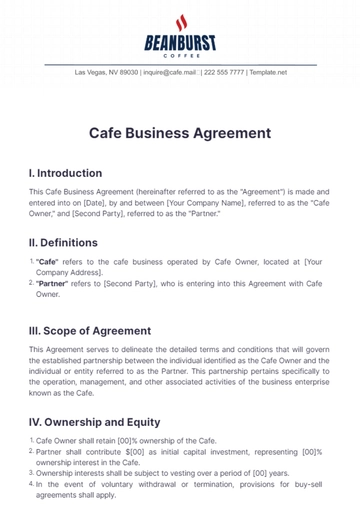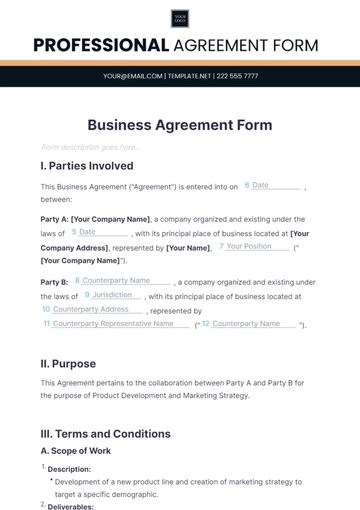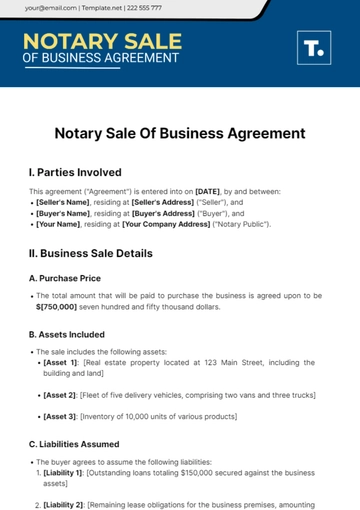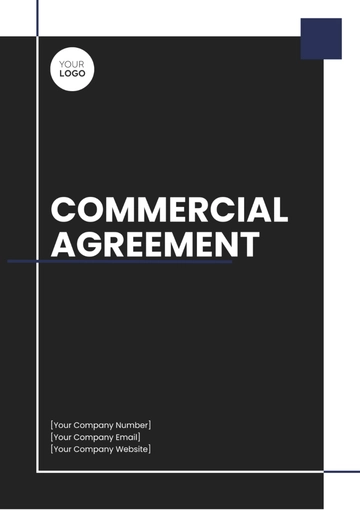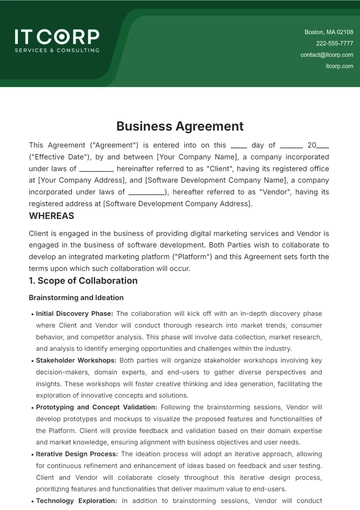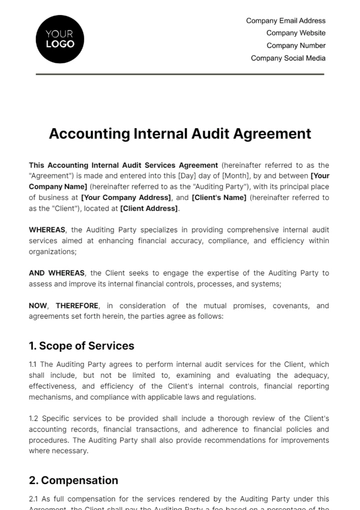Free Business Agreement
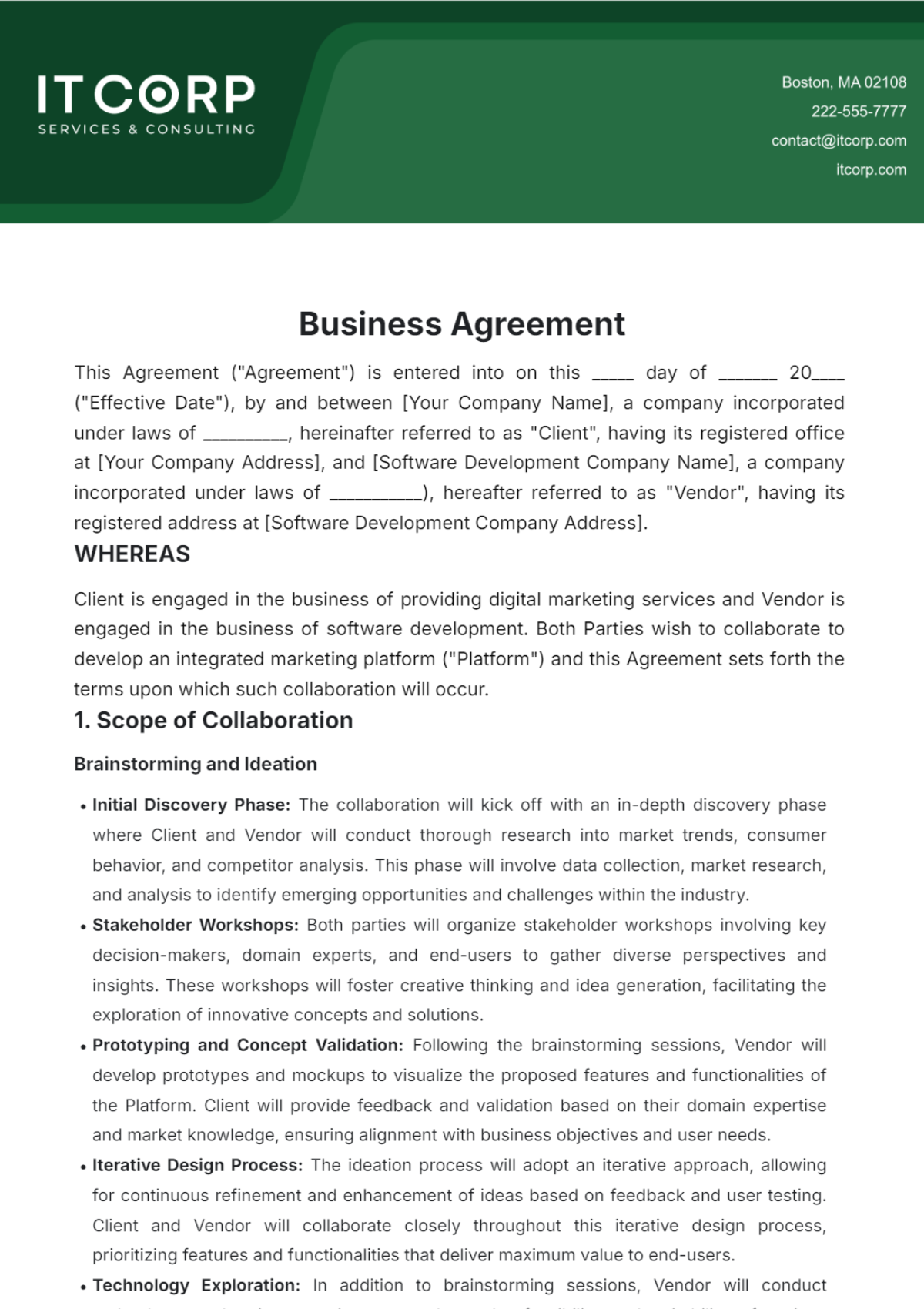
This Agreement ("Agreement") is entered into on this _____ day of _______ 20____ ("Effective Date"), by and between [Your Company Name], a company incorporated under laws of __________, hereinafter referred to as "Client", having its registered office at [Your Company Address], and [Software Development Company Name], a company incorporated under laws of ___________), hereafter referred to as "Vendor", having its registered address at [Software Development Company Address].
WHEREAS
Client is engaged in the business of providing digital marketing services and Vendor is engaged in the business of software development. Both Parties wish to collaborate to develop an integrated marketing platform ("Platform") and this Agreement sets forth the terms upon which such collaboration will occur.
1. Scope of Collaboration
Brainstorming and Ideation
Initial Discovery Phase: The collaboration will kick off with an in-depth discovery phase where Client and Vendor will conduct thorough research into market trends, consumer behavior, and competitor analysis. This phase will involve data collection, market research, and analysis to identify emerging opportunities and challenges within the industry.
Stakeholder Workshops: Both parties will organize stakeholder workshops involving key decision-makers, domain experts, and end-users to gather diverse perspectives and insights. These workshops will foster creative thinking and idea generation, facilitating the exploration of innovative concepts and solutions.
Prototyping and Concept Validation: Following the brainstorming sessions, Vendor will develop prototypes and mockups to visualize the proposed features and functionalities of the Platform. Client will provide feedback and validation based on their domain expertise and market knowledge, ensuring alignment with business objectives and user needs.
Iterative Design Process: The ideation process will adopt an iterative approach, allowing for continuous refinement and enhancement of ideas based on feedback and user testing. Client and Vendor will collaborate closely throughout this iterative design process, prioritizing features and functionalities that deliver maximum value to end-users.
Technology Exploration: In addition to brainstorming sessions, Vendor will conduct technology exploration exercises to evaluate the feasibility and suitability of various technical solutions. This may involve researching emerging technologies, assessing scalability options, and identifying potential integration challenges to inform the design and development process.
Design and Development
Architectural Design: Vendor will commence the design phase by creating a comprehensive architectural blueprint that outlines the structure, components, and interactions of the Platform. This architectural design will serve as the foundation for the development efforts, ensuring scalability, flexibility, and maintainability of the software solution.
Agile Development Methodology: The development process will follow agile methodologies, with iterative cycles of planning, development, testing, and deployment. Vendor will organize regular sprint meetings and demonstrations to review progress, gather feedback, and adjust priorities accordingly. This agile approach will enable Client to actively participate in the development process, ensuring transparency and alignment with project goals.
User-Centric Design Principles: Throughout the development lifecycle, Vendor will prioritize user-centric design principles to create intuitive and engaging user experiences. This includes conducting user research, creating personas, and designing user journeys to empathize with end-users and anticipate their needs. Client will provide valuable insights into target audience demographics, preferences, and pain points to inform the design decisions.
Cross-Functional Collaboration: The design and development teams will collaborate cross-functionally to integrate design thinking, software engineering, and marketing expertise into the development process. This interdisciplinary approach will foster innovation and creativity, resulting in a holistic solution that seamlessly integrates marketing strategies with software functionalities.
Quality Assurance and Code Review: Rigorous quality assurance measures will be implemented throughout the development process to ensure the reliability, performance, and security of the Platform. Vendor will conduct thorough code reviews, unit testing, and integration testing to identify and rectify any defects or vulnerabilities. Client will participate in user acceptance testing (UAT) to validate the software against predefined acceptance criteria and business requirements.
Testing and Deployment
Comprehensive Testing Strategy: Vendor will develop a comprehensive testing strategy encompassing functional testing, usability testing, performance testing, security testing, and compatibility testing. This multi-faceted approach will ensure the Platform's robustness, usability, and compatibility across various devices, browsers, and operating systems.
Test Automation Framework: To expedite the testing process and improve efficiency, Vendor will leverage test automation frameworks and tools to automate repetitive test cases and regression testing. This automation will streamline the testing workflow, accelerate time-to-market, and enhance overall software quality.
User Acceptance Testing (UAT): Client will conduct user acceptance testing (UAT) in a simulated production environment to validate the Platform's functionality and user experience. This UAT phase will involve end-users and stakeholders interacting with the software solution to identify any issues or discrepancies and provide feedback for refinement.
Deployment Planning: Prior to deployment, Vendor will develop a comprehensive deployment plan outlining the sequence of activities, dependencies, and contingencies involved in releasing the Platform to production. This plan will address factors such as data migration, system configuration, user training, and post-deployment support to ensure a smooth transition from development to production environment.
2. Responsibilities
Client Responsibilities
Provide Digital Marketing Expertise and Insights
The Client will leverage its extensive experience and expertise in digital marketing to provide valuable insights into market trends, consumer behavior, and industry best practices. This input will guide the development process, ensuring that the Platform aligns with current market demands and strategic marketing objectives.
Client will share insights on emerging technologies, digital advertising strategies, and content marketing techniques to enhance the Platform's effectiveness in reaching and engaging target audiences.
Collaborate in Defining Platform's Target Audience and Market Positioning
The Client will collaborate closely with the Vendor to define the Platform's target audience segments, demographic profiles, and psychographic characteristics. Through collaborative discussions and market research, both parties will identify the ideal customer personas and tailor the Platform's features and functionalities to meet their specific needs and preferences.
Client will contribute to defining the Platform's unique value proposition and market positioning strategies, ensuring that it effectively differentiates itself from competitors and resonates with the target audience.
Assist in Identification of Key Performance Indicators (KPIs) and Metrics
Client will actively participate in defining the key performance indicators (KPIs) and success metrics that will be used to evaluate the effectiveness and ROI of the Platform. These KPIs may include metrics such as user engagement, conversion rates, customer acquisition cost (CAC), retention rates, and return on investment (ROI).
Client will provide input on setting realistic performance targets and benchmarks based on industry benchmarks, historical data, and business objectives. Regular monitoring and analysis of these KPIs will inform strategic decision-making and optimization efforts throughout the Platform's lifecycle.
Vendor Responsibilities
Develop and Implement Software Architecture, Database Design, and User Interface Components
The Vendor will be responsible for translating the conceptual requirements and design specifications provided by the Client into a robust and scalable software solution. This includes designing and implementing the underlying software architecture, database schema, and user interface components of the Platform.
Vendor will leverage its technical expertise in software development, utilizing industry-standard frameworks, programming languages, and development methodologies to build a stable and efficient Platform that meets the Client's requirements and expectations.
Ensure Platform Meets Industry Standards for Security, Data Privacy, and Regulatory Compliance
Vendor will prioritize security and data privacy throughout the development lifecycle, implementing stringent security measures to safeguard sensitive information and protect against potential cyber threats and data breaches. This includes adhering to industry best practices, standards, and regulations such as GDPR, HIPAA, and PCI DSS.
Vendor will conduct regular security audits and vulnerability assessments to identify and mitigate any potential security risks or compliance issues. Proactive measures will be taken to address vulnerabilities, apply security patches, and implement encryption protocols to enhance data protection and regulatory compliance.
Provide Ongoing Technical Support, Maintenance, and Updates
Vendor will offer comprehensive technical support and maintenance services to ensure the smooth operation and optimal performance of the Platform post-deployment. This includes troubleshooting technical issues, resolving software bugs, and providing timely assistance to users and administrators.
Vendor will proactively monitor the Platform's performance and stability, implementing performance optimizations and software updates as needed to address evolving business requirements and technological advancements. Regular maintenance tasks such as database backups, system upgrades, and security patches will be performed to minimize downtime and ensure data integrity.
3. Intellectual Property Rights
Ownership and Joint Collaboration
Both the Client and the Vendor acknowledge and agree that any intellectual property developed during the course of their collaboration, including but not limited to software code, designs, algorithms, documentation, and any other creative works, shall be considered jointly owned by both parties.
This joint ownership reflects the collaborative nature of the development process, where both parties contribute their expertise, resources, and creative input towards the creation of the Platform. It ensures that both parties have equal rights and interests in the intellectual property resulting from their collaboration.
Joint ownership facilitates a fair and equitable distribution of rights and responsibilities, enabling both parties to leverage and benefit from the intellectual property developed during the collaboration. It promotes transparency, trust, and mutual respect in the relationship between the Client and the Vendor.
Use and Licensing
Client and Vendor mutually agree to grant each other non-exclusive licenses to utilize the jointly owned intellectual property for the purposes outlined in this Agreement. This includes the right to use, modify, reproduce, distribute, and sublicense the intellectual property as necessary to fulfill their respective obligations and objectives under the Agreement.
The non-exclusive nature of the licenses allows both parties the freedom to exploit the intellectual property for their own business purposes, while also preserving their rights to collaborate with other partners or stakeholders as desired.
Client may use the jointly owned intellectual property to enhance its digital marketing services, integrate the Platform with its marketing strategies, and deliver value-added solutions to its clients. Similarly, Vendor may leverage the intellectual property to further develop and enhance its software solutions, expand its product offerings, and serve a broader customer base.
Both parties agree to abide by the terms and conditions governing the use of the jointly owned intellectual property, including any restrictions on sublicensing, transferability, or commercialization. Any unauthorized use or exploitation of the intellectual property beyond the scope of this Agreement shall require the prior consent of both parties.
4. Revenue Sharing and Financial Arrangements
Revenue Allocation
The Client and the Vendor shall collaborate to establish a mutually beneficial revenue-sharing model that fairly reflects the contributions, investments, and risks undertaken by each party in the development and promotion of the platform.
As per the initial agreement, the revenue-sharing model stipulates that the Client shall receive 60% of the revenue generated from the Platform, while the Vendor shall receive 40%. This allocation is based on the respective roles and responsibilities of each party, as well as the anticipated value derived from the Platform's commercialization.
The revenue-sharing model may be subject to periodic review and adjustment based on changing market conditions, performance metrics, and strategic objectives. Both parties commit to engaging in open and constructive discussions to ensure that the revenue allocation remains equitable and aligned with the evolving needs of the partnership.
Financial Transparency
To foster transparency and accountability in revenue distribution, detailed financial statements and reports shall be maintained and shared periodically between the Client and the Vendor. These financial statements will provide a comprehensive overview of the Platform's revenue streams, expenses, profitability, and other relevant financial metrics.
The frequency and format of financial reporting shall be determined through mutual agreement between the parties, taking into account the complexity of the financial arrangements and the need for timely decision-making.
Financial reports may include but are not limited to, income statements, balance sheets, cash flow statements, revenue forecasts, expense breakdowns, and variance analyses. These reports will enable both parties to track the financial performance of the Platform, identify areas for improvement, and make informed strategic decisions.
In addition to regular financial reporting, both parties commit to maintaining open lines of communication and collaboration on financial matters. This includes discussing any significant financial developments, deviations from budgeted targets, and potential risks or opportunities that may impact revenue generation and distribution.
Financial transparency not only promotes trust and accountability between the Client and the Vendor but also facilitates effective financial management, risk mitigation, and strategic planning. By sharing financial information openly and proactively, both parties can align their interests, optimize resource allocation, and maximize the long-term success of the partnership.
5. Dispute Resolution Mechanisms
Negotiation and Amicable Settlement
In the event of any disputes, differences, or disagreements arising under this Agreement, the Client and the Vendor commit to resolving them promptly and amicably through good-faith negotiations and discussions.
Both parties recognize the importance of maintaining a positive and constructive working relationship, and therefore, agree to approach dispute resolution with a spirit of cooperation, flexibility, and mutual respect.
The negotiation process will involve open communication, active listening, and a willingness to consider each other's perspectives and interests. Both parties will make reasonable efforts to find mutually acceptable solutions that preserve the integrity of the Agreement and the ongoing collaboration.
Arbitration
Should the parties fail to reach a resolution through negotiation, any unresolved disputes shall be referred to arbitration as the next step in the dispute resolution process.
Arbitration offers a private, efficient, and cost-effective alternative to traditional litigation, providing a neutral forum for the parties to present their arguments and evidence before an impartial arbitrator or panel of arbitrators.
The arbitration proceedings shall be conducted in accordance with the rules and procedures of a mutually agreed-upon arbitration body, such as the American Arbitration Association (AAA), the International Chamber of Commerce (ICC), or another recognized arbitration institution.
The parties will cooperate in selecting a qualified arbitrator or panel of arbitrators with relevant expertise and experience in the subject matter of the dispute. The arbitrator's decision shall be final and binding on both parties, and may be enforced in accordance with applicable law.
By agreeing to arbitration, the Client and the Vendor demonstrate their commitment to resolving disputes in a fair, impartial, and expeditious manner, while also avoiding the delays, costs, and uncertainties associated with traditional litigation.
6. Representations and Warranties
Authority and Compliance
Both the Client and the Vendor represent and warrant that they possess the requisite legal authority, capacity, and power to enter into this Agreement and to fulfill all obligations and commitments contained herein.
This includes, but is not limited to, obtaining any necessary approvals, consents, or authorizations from relevant stakeholders, corporate entities, or regulatory bodies required to validly execute and perform under this Agreement.
The parties further represent and warrant that their execution and performance of this Agreement do not violate any applicable laws, regulations, or contractual obligations, and that they are in compliance with all relevant legal and regulatory requirements.
Non-Infringement
The Client and the Vendor warrant that their respective activities under this Agreement, including but not limited to the development, use, and exploitation of the Platform, will not infringe upon the intellectual property rights of any third parties.
This includes patents, copyrights, trademarks, trade secrets, and any other proprietary rights owned or controlled by third parties. Both parties affirm that they have conducted due diligence and taken reasonable precautions to ensure that their activities do not constitute infringement
In the event of any allegations or claims of intellectual property infringement arising from the Client's or the Vendor's activities under this Agreement, the party responsible for the alleged infringement shall promptly notify the other party and take appropriate remedial action to address the issue.
7. Signatures

[Your Name]
[Your Company Name]
[Month Day, Year]

[Your Name]
[Vendor Company Name]
[Month Day, Year]
- 100% Customizable, free editor
- Access 1 Million+ Templates, photo’s & graphics
- Download or share as a template
- Click and replace photos, graphics, text, backgrounds
- Resize, crop, AI write & more
- Access advanced editor
You may also like
- Lease Agreement
- Non Compete Agreement
- Rental Agreement
- Prenuptial Agreement
- Non Disclosure Agreement
- Operating Agreement
- Hold Harmless Agreement
- LLC Operating Agreement
- Arbitration Agreement
- Purchase Agreement
- Residential Lease Agreement
- Executive Agreement
- Confidentiality Agreement
- Contractor Agreement
- Partnership Agreement
- Postnuptial Agreement
- Collective Bargaining Agreement
- Loan Agreement
- Roommate Agreement
- Commercial Lease Agreement
- Separation Agreement
- Cohabitation Agreement
- Room Rental Agreement
- Child Custody Agreement
- Employee Agreement
- License Agreements
- Settlement Agreement
- Joint Venture Agreement
- Indemnity Agreement
- Subordination Agreement
- Sales Agreement
- Agreements Between Two Parties
- Business Agreement
- Real Estate Agreement
- HR Agreement
- Service Agreement
- Property Agreement
- Agreement Letter
- Restaurant Agreement
- Construction Agreement
- Finance Agreement
- Marketing Agreement
- Payment Agreement
- Investment Agreement
- Management Agreement
- Nonprofit Agreement
- Software Agreement
- Startup Agreement
- Agency Agreement
- Copyright Agreement
- Collaboration Agreement
- Reseller Agreement
- Car Rental Agreement
- Cleaning Services Agreement
- Consultant Agreement
- Deed Agreement
- Car Agreement
- Equipment Agreement
- Shares Agreement
- Data Sharing Agreement
- Advertising Agreement
- School Agreement
- Franchise Agreement
- Event Agreement
- Travel Agency Agreement
- Vehicle Agreement
- Board Resolution Agreement
- Land Agreement
- Binding Agreement
- Tenancy Agreement
- Exclusive Agreement
- Development Agreement
- Assignment Agreement
- Design Agreement
- Equity Agreement
- Mortgage Agreement
- Purchase and Sale Agreement
- Shareholder Agreement
- Vendor Agreement
- Royalty Agreement
- Vehicle Lease Agreement
- Hotel Agreement
- Tenant Agreement
- Artist Agreement
- Commission Agreement
- Consignment Agreement
- Debt Agreement
- Recruitment Agreement
- Training Agreement
- Transfer Agreement
- Apprenticeship Agreement
- IT and Software Agreement
- Referral Agreement
- Resolution Agreement
- Waiver Agreement
- Consent Agreement
- Partner Agreement
- Social Media Agreement
- Customer Agreement
- Credit Agreement
- Supply Agreement
- Agent Agreement
- Brand Agreement
- Law Firm Agreement
- Maintenance Agreement
- Mutual Agreement
- Retail Agreement
- Deposit Agreement
- Land Purchase Agreement
- Nursing Home Agreement
- Supplier Agreement
- Buy Sell Agreement
- Child Support Agreement
- Landlord Agreement
- Payment Plan Agreement
- Release Agreement
- Research Agreement
- Sponsorship Agreement
- Buyout Agreement
- Equipment Rental Agreement
- Farm Agreement
- Manufacturing Agreement
- Strategic Agreement
- Termination of Lease Agreement
- Compliance Agreement
- Family Agreement
- Interior Design Agreement
- Ownership Agreement
- Residential Lease Agreement
- Retainer Agreement
- Trade Agreement
- University Agreement
- Broker Agreement
- Dissolution Agreement
- Funding Agreement
- Hosting Agreement
- Investor Agreement
- Memorandum of Agreement
- Advisory Agreement
- Affiliate Agreement
- Freelancer Agreement
- Grant Agreement
- Master Service Agreement
- Parking Agreement
- Subscription Agreement
- Trust Agreement
- Cancellation Agreement
- Horse Agreement
- Influencer Agreement
- Membership Agreement
- Vacation Rental Agreement
- Wholesale Agreement
- Author Agreement
- Distributor Agreement
- Exchange Agreement
- Food Agreement
- Guarantee Agreement
- Installment Agreement
- Internship Agreement
- Music Agreement
- Severance Agreement
- Software Development Agreement
- Storage Agreement
- Facility Agreement
- Intercompany Agreement
- Lending Agreement
- Lodger Agreement
- Outsourcing Services Agreement
- Usage Agreement
- Assurance Agreement
- Photography Agreement
- Profit Sharing Agreement
- Relationship Agreement
- Rent To Own Agreement
- Repayment Agreement
- Volunteer Agreement
- Co Parenting Agreement
- HVAC Agreement
- Lawn Care Agreement
- SAAS Agreement
- Work from Home Agreement
- Coaching Agreement
- Protection Agreement
- Security Agreement
- Repair Agreement
- Agreements License



